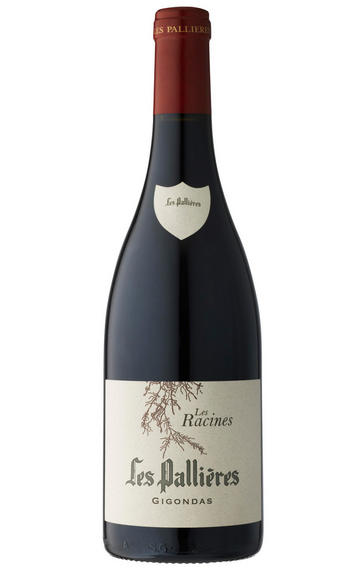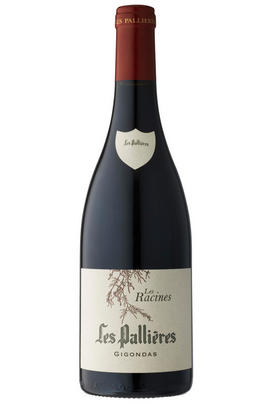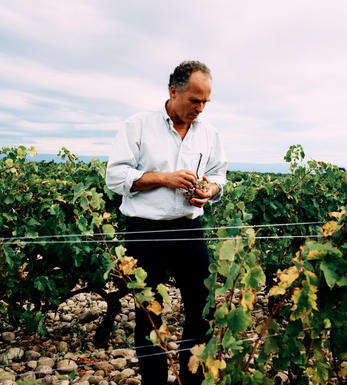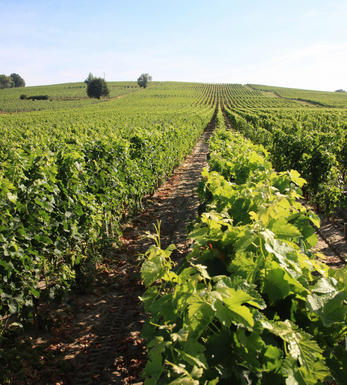
2010 Gigondas, Les Racines, Domaine Les Pallières, Vignobles Brunier, Rhône

Critics reviews
Robert M. Parker, Jr. - 31/10/2012
(Robert Parker - Wine Advocate - Oct 2011)
About this WINE

Vieux Telegraphe
Vieux Télégraphe is one of the most renowned estates in the Southern Rhône. Blessed with the finest locations in the area on the famed La Crau plateau, there is an emphasis on terroir expression and natural winemaking. The Bruniers, who own the property, started their love affair with La Crau in 1898 and on which they now own 70ha. This plateau – a Grand Cru equivalent in Châteauneuf-du-Pape – is so reputed for several reasons. Firstly, its galets roules (pudding stones) that re-emit the heat of the sun, producing a warm microclimate ideal for even berry ripening. Beneath these lies a subsoil of clay, which counters excess heat by keeping the vines hydrated and cool. Finally, at 120m altitude, it sits higher than surrounding areas. This brings exposure to wind (notably the Mistral), which again keeps the vines cool and free from diseases (and occasionally frost).
In 2021, the domaine was lucky to have been spared the worst of the flash frost that hit the region in April. Pallières was slightly impacted, but Piedlong and La Crau both emerged unscathed. The family did, nonetheless, see a moderate drop in yield due to the rains, with Vieux Télégraphe down by about 30%. Winemaker Daniel Brunier describes the vintage as classic, breaking the long series of “solaire” vintages we’ve seen since 2015. The wines show freshness but the slow and complete ripening brought about by a later-than-usual harvest brought with it concentration of flavours and balance. Daniel believes the wines will produce some wonderful surprises throughout the course of their ageing.
Alongside their Châteauneuf properties, the Brunier family owns Domaine des Pallières in Gigondas – a mixed farming estate set within the Provençal Forest. There they were not impacted by the rains (or indeed frost) in the same way. Daniel is extremely proud of the vintage. He describes the wines as pure, linear, with more moderate levels of alcohol and showing great sophistication and balance. He believes his Racines to be one of the best he has ever made.

Gigondas
Gigondas has been renowned for the quality of its wines since Roman times, although it was not really until it was classified as a Côtes du Rhône Villages in 1966 that it began to realise its potential. It achieved AC status in 1971 and today produces some of the finest, most underrated and under-priced wines in the Rhône valley; although, for the last two of these at least, probably not for much longer.
Gigondas' 1,200-hectare of rugged vineyards are located east of Châteauneuf-du-Pape, beneath the famous mountains of Dentelles de Montmirail. Gigondas produces sumptuous, plummy reds with a good structure and a sprinkle of pepper. It is similar to (if a touch less slick than) good Châteauneuf-du-Pape which, at its best, it can challenge and even surpass.
Made with a maximum of 80 percent Grenache, combined with at least 15 percent Syrah and/or Mourvèdre, the rest can be made of any of the varieties authorized for Côtes du Rhône – apart from Carignan. The wines can normally be broached after two to three years, while the best repay ageing for 10 years or more. The region also produces dry, Grenache-dominated rosés which are good but can sometimes lack a little vitality.
Recommended Producer: La Bastide St Vincent, Domaine Montirius

Southern Rhône Blend
The vast majority of wines from the Southern Rhône are blends. There are 5 main black varieties, although others are used and the most famous wine of the region, Châteauneuf du Pape, can be made from as many as 13 different varieties. Grenache is the most important grape in the southern Rhône - it contributes alcohol, warmth and gentle juicy fruit and is an ideal base wine in the blend. Plantings of Syrah in the southern Rhône have risen dramatically in the last decade and it is an increasingly important component in blends. It rarely attains the heights that it does in the North but adds colour, backbone, tannins and soft ripe fruit to the blend.
The much-maligned Carignan has been on the retreat recently but is still included in many blends - the best old vines can add colour, body and spicy fruits. Cinsault is also backtracking but, if yields are restricted, can produce moderately well-coloured wines adding pleasant-light fruit to red and rosé blends. Finally, Mourvèdre, a grape from Bandol on the Mediterranean coast, has recently become an increasingly significant component of Southern Rhône blends - it often struggles to ripen fully but can add acidity, ripe spicy berry fruits and hints of tobacco to blends.


Buying options
Add to wishlist
Description
As the names suggest, Les Racines is sourced from lower vineyards than Les Terrasses ( Daniel’s other Gigondas) , but from older vines, over 65 years of age in the case of the Grenache which makes up 90% of this cuvée, the balance made up of Mourvèdre. A surprisingly feminine floral aromatic is followed by a fine and elegant palate with notes of myrtle and licorice, mocha and forest floor all evidenced.
Simon Field MW, BBR Buyer, February 2012
Daniel Brunier detects a ‘strong sinewy’ character in his 2010s, something of the 2005 in other words, but with greater depth. His wines are perhaps more Roundhead than the Cavalier vintages of 2009 and 2007 and will be very long-lasting as a result. The on-going evolution ( if you will pardon the tautology) of La Roquète continues to impress and les Pallières bears virtually no resemblance at all to the raw and sinewy Gigondas I first encountered, with no lack of trepidation, a decade ago.
wine at a glance
Delivery and quality guarantee